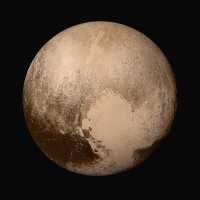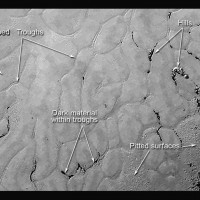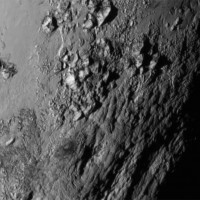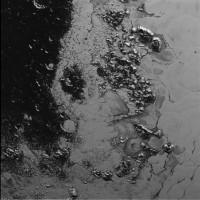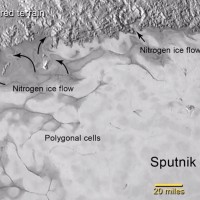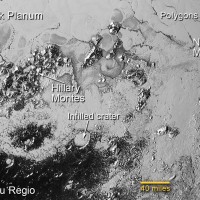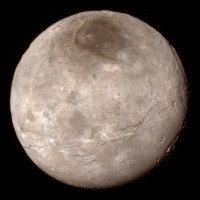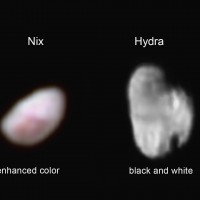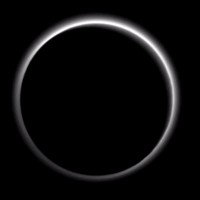The Lord of the Underworld gives up its secrets
After 3 billion miles and nine and a half years, NASA’s New Horizons has passed Pluto and entered the farthest reaches of our galaxy. Dr. Scott Kenyon of the Harvard-Smithsonian Astrophysical Observatory, tells us what we know and what we hope to learn from this dark and frigid ball of ice.
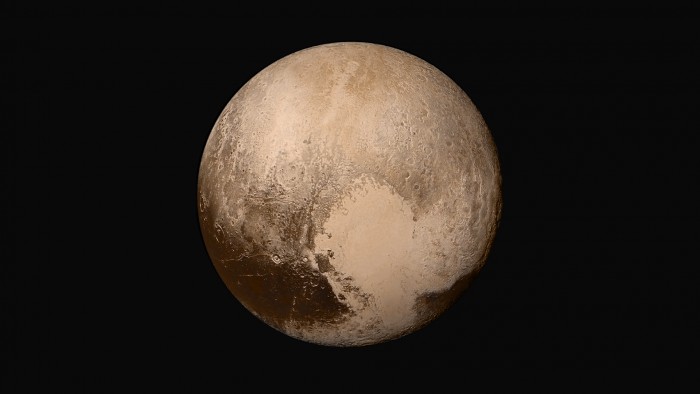
This global view of Pluto, taken when the spacecraft was 280,000 miles away, show features as small as 1.4 miles, twice the resolution of the single-image view taken on July 13. Credit: NASA/JHUAPL/SWRI
On July 14, after a 3 billion-mile voyage that took nine and a half years, NASA’s New Horizons probe whizzed past Pluto and its moons. The resulting photos represent our first up-close look at this icy world on the edge of our solar system. And it turns out that Pluto is full of surprises.
Smithsonian astrophysicist Scott Kenyon studies the formation and history of the Pluto system using computer simulations. Those simulations also helped guide New Horizons on a safe path free of dust and debris. We asked Dr. Kenyon about New Horizons, what we have already learned about this remote member of our solar system, and what we may still find out.
Why visit Pluto? What makes it special or interesting to scientists?
Aside from its significance as the last of the “classical” planets to be explored by a NASA mission, it is also the Gateway to the Kuiper Belt. Beyond the orbit of Neptune, thousands of iceballs orbit the Sun in a region called the Kuiper (pronounced KY-per) Belt. A few of these are almost as large as Pluto. Others are less than half a mile across. Some are even smaller. All are remnants of the protosolar disk where the planets of our solar system formed more than 4 billion years ago. By studying Pluto, its large moon Charon, and the four smaller moons, we hope to learn about the conditions that led to the formation of all of the planets.
How would you describe your work on the Pluto system?
I study how Pluto and other planets form out of the protosolar disk. Originally, this disk contained mostly hydrogen and helium, some trace elements like carbon and nitrogen, and small solid particles. These particles collide and merge into larger and larger objects, eventually becoming planets and moons. My colleague Ben Bromley (at the University of Utah) and I simulate this process on a fast supercomputer. Aside from learning how the properties of planets depend on the conditions in the disk, we make predictions which can test our theory. For Pluto, our computer simulations predict that the system should have some very small moons outside the orbit of Hydra. We’re looking forward to New Horizons data that can test our prediction.
What do you think of the data we’ve gotten from New Horizons so far?
The images of Pluto and its largest moon, Charon are amazing and very surprising. Everyone expected both worlds to be covered by craters. But there are very few! The mountains on Pluto are incredible, like having 60,000-foot mountains on Earth. These are totally unexpected. And Charon has a spectacular canyon 4 to 6 miles deep. Imagine a 60-mile deep Grand Canyon on Earth!
The images of the moons Nix and Hydra are also fascinating. Both have shapes like a potato or football, similar to some asteroids with comparable sizes. Each has a set of bright and dark regions. I am looking forward to the complete set of images to get a better idea of the overall shape and composition of both moons.
What is your favorite photo from New Horizons?
So far, I have most enjoyed the mountains on Pluto. The terrain on Pluto is so varied, but the mountains seem to cover an impressive fraction of the entire surface.
What has been the most surprising thing we’ve seen?
It is hard to say whether the mountains on Pluto or the canyons on Charon are the most surprising. I don’t think anyone expected either one.
Unlike our Moon, Pluto doesn’t seem to have a lot of impact craters. What does that tell us about it?
On the latest images, Pluto and Charon have some fairly large craters, but not nearly as many as expected. Over the past 4 billion years or so, Pluto and Charon have been struck by thousands (maybe millions) of little iceballs left over from the formation of the solar system. Everyone anticipated that Pluto and Charon would be completely frozen all the time. Iceballs striking the surface should melt the surrounding ice which would eventually re-freeze as a crater. Over 4.5 billion years, strikes by lots of iceballs should have made lots of craters. We expected to be able to count all of the craters and reconstruct the history of impacts.
With so few craters, the surface must be much younger than 4.5 billion years old, maybe less than a hundred million. Some activity on the surface must somehow erase or fill in the craters. On Earth, water and wind slowly erode impact craters over many thousands of years. Over longer periods, plate tectonics obliterates craters. Pluto and Charon do not have any wind, but the most recent images show some evidence for giant ice flows on the surface. These kinds of flows can easily obliterate craters. If Pluto has a large underground ocean, the ocean may drive some type of plate tectonics which could also erode the craters.
Every new set of images from New Horizons shows more details in the mountains and the ice on the surface. After a month or two, we will probably have another set of ideas for the lack of craters on Pluto and Charon.
Why do you think Pluto and its largest moon, Charon look so different from each other?
Around the time the Earth was forming, Pluto and Charon grew out of icy solids in different regions of the protosolar disk. Eventually, Charon collided with Pluto, skimming off some material from each world. Some of this skimmed off material became the small moons, Styx, Nix, Kerberos, and Hydra. The rest fell back onto Pluto and Charon.
Because they formed in different parts of the protosolar disk, they probably formed with different amounts of nitrogen, water, ammonia, and methane which are the primary constituents of both worlds. The collision probably also dramatically changed their appearance. Finally, Pluto and Charon have big tides like the Earth and the Moon; these probably also changed the surfaces.
What comes next?
Over the next 16 months, the computer on New Horizons will patiently transmit all of the data from the mission back to Earth. Aside from new images, the data will include spectroscopy and measurements of the amount of dust and other small particles in the system. These data will allow us to construct an amazingly detailed picture of the entire system.
After that, New Horizons’ journey continues. Later this summer, the team will choose another iceball to visit. Sometime in 2019, New Horizons will rendezvous with this world and we will have another treat!
- This global view of Pluto, taken when the spacecraft was 280,000 miles away, show features as small as 1.4 miles, twice the resolution of the single-image view taken on July 13. Credit: NASA/JHUAPL/SWRI
- In the center left of Pluto’s vast heart-shaped feature – informally named “Tombaugh Regio” – lies a vast, craterless plain that appears to be no more than 100 million years old, and is possibly still being shaped by geologic processes. This frozen region is north of Pluto’s icy mountains and has been informally named Sputnik Planum (Sputnik Plain), after Earth’s first artificial satellite. The surface appears to be divided into irregularly-shaped segments that are ringed by narrow troughs. Features that appear to be groups of mounds and fields of small pits are also visible. Features as small as one-half mile across are visible. The blocky appearance of some features is due to compression of the image. Credit: NASA/JHUAPL/SWRI
- This close-up image of a region near Pluto’s equator reveals a giant surprise: a range of youthful mountains rising as high as 11,000 feet above the surface of the icy body. The mountains likely formed no more than 100 million years ago — mere youngsters relative to the 4.56-billion-year age of the solar system — and may still be in the process of building. Credit: NASA/JHUAPL/SWRI
- A newly discovered mountain range lies near the southwestern margin of Pluto’s heart-shaped Tombaugh Regio (Tombaugh Region), situated between bright, icy plains and dark, heavily-cratered terrain. These frozen peaks are estimated to be one-half mile to one mile high, about the same height as the United States’ Appalachian Mountains. Credit: NASA/JHUAPL/SWRI
- In the northwestern region of Pluto’s Sputnik Planum, swirl-shaped patterns of light and dark suggest that a surface layer of exotic ices has flowed around obstacles and into depressions, much like glaciers on Earth. This is evidence for geologically recent surface activity. Credit: NASA/JHUAPL/SWRI
- The southern region of Pluto’s Sputnik Planum contains newly discovered ranges of mountains that have been informally named Hillary Montes (Hillary Mountains) and Norgay Montes (Norgay Montes) for Sir Edmund Hillary and Tenzing Norgay, the first two humans to reach the summit of Mount Everest in 1953. These mountains are made of water ice, which is hard as rock at Pluto’s low temperature. Credit: NASA/JHUAPL/SWRI
- Remarkable new details of Pluto’s largest moon Charon are revealed in this image, taken from a distance of 289,000 miles. A swath of cliffs and troughs stretches about 600 miles from left to right, suggesting widespread fracturing of Charon’s crust, likely a result of internal processes. At upper right, along the moon’s curving edge, is a canyon estimated to be 4 to 6 miles deep. Credit: NASA/JHUAPL/SWRI
- Pluto’s moon Nix (left), shown here in enhanced color, has a reddish spot that has attracted the interest of mission scientists. At the time the observations were taken New Horizons was about 102,000 miles from Nix. The image shows features as small as approximately 2 miles across on Nix, which is estimated to be 26 miles long and 22 miles wide.
- Speeding away from Pluto just seven hours after its July 14 closest approach, the New Horizons spacecraft looked back and captured this spectacular image of Pluto’s atmosphere, backlit by the sun. The image reveals layers of haze, giving us our first peek at Pluto’s weather. Credit: NASA/JHUAPL/SWRI
Posted: 27 July 2015
